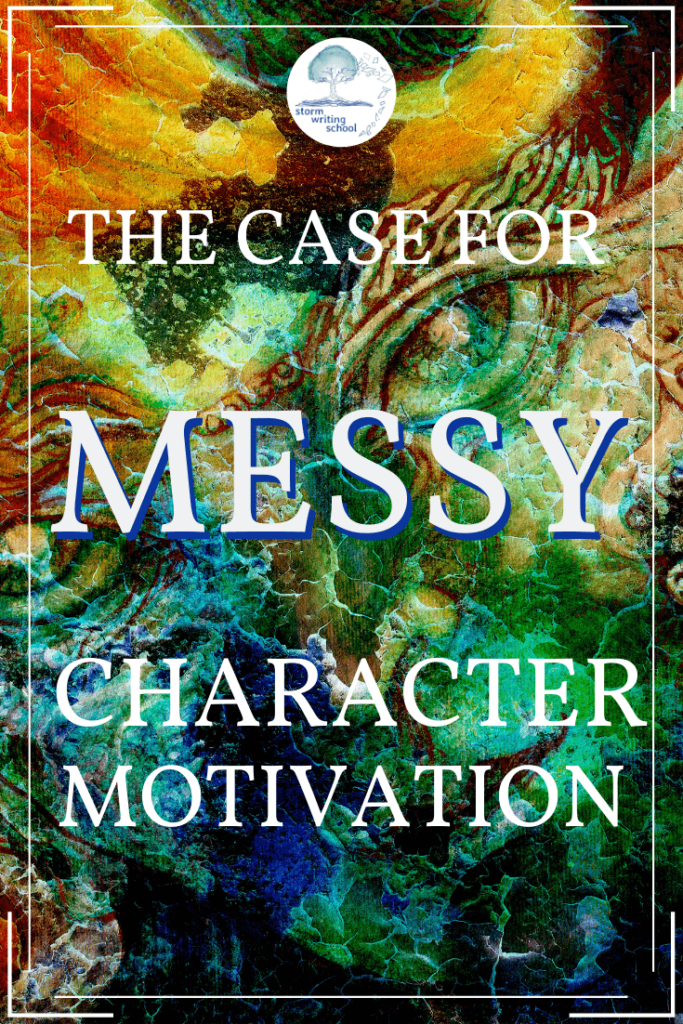Is it necessary for writers to understand their character motivation?
There’s a camp of writing instruction that makes very intimidating claims about how well you have to know your characters. They advise that you create extensive backstories and fill out long questionnaires. And they certainly want you to know your characters’ motivations.
When it comes to process, to each his own, I say. If mulling over extensive profiles helps you imagine a character into existence, then more power to you.
But just for the sake of argument, I want to present a case for discovering your characters through the story and leaving some mystery about why they act like they do.

Story People
In his book Techniques of the Selling Writing, Dwight Swain asks, “To what extent is a character like a real person– a living, breathing human being?”
His answer: “At a generous estimate, about 1/1000 of 1%. This is so is because a living person is infinitely complex. A story person, on the other hand, is merely a simulation of a living person. So he’s infinitely simpler. Space and function limit him.”
Swain refers to characters as “story people” and urges writers to “develop a character only to that limited degree that he needs to be developed, in order to fulfill his function in the story. You give an impression and approximation of life, rather than attempting to duplicate life itself.”
It’s hard for writers to admit just how limited our characters are. We live with these imaginary people for years sometimes, and we often feel we know them as much as we know any real person.
And given the penchant for writers to be anti-social recluses, I suppose maybe that’s possible. But characters are not real people. Your job as a writer is to make them seem real, but they aren’t.
Messy Motivation
In fact, if you’re trying to make characters seem real, one of the best things you can do is make their motives messy. Because in real life, our motives involve a mixture of complicated personal history, personality traits, and cultural forces.
As Rust Hills points out, “It is seldom possible to demonstrate how a motive caused a certain act in any one-to-one relationship. Any interesting act is usually the result of mixed motives. The same act in different individuals under different circumstances may be the result of entirely different motives. And the same motive in different individuals and under different circumstances may result in entirely different acts.”
One might argue, therefore, that the deeper your character development and the truer to life you want to be, the messier the motivations should be. “With some exceptions,” Hills argues, “all the intriguing characters in literature have very unclear motivation.”
Ponder But Don’t Pin Down
This is not to say that you shouldn’t explore your characters’ motivations at all. When I’m editing stories—either my own or others’—I do often ask questions about why the character is acting this particular way at this particular point in time. Readers expect to see some causality behind behavior.
But that doesn’t mean they need clear, unambiguous explanation at all times. In fact, it’s just the opposite: readers often prefer to guess at motivations.
You, the writer might have some theories about why a character acted or reacted in a certain way, but the reader need not always share those theories. Readers enjoy the surprise when characters act in unexpected ways. And readers like to ponder how and why characters came to behave like they do.
So you’ll often have better reader engagement when motivations aren’t clear.
Robert McKee says it well: “Generally, the more the writer nails motivation to specific causes, the more he diminishes the character in the audience’s mind. Leave some mystery around the whys, a touch of the irrational perhaps, room for the audience to use its own life experience to enhance your character in its imagination.”
Birthed by Story
But I want to emphasize that when I ask questions about why a character is acting a particular way at a particular time, that behavior is context-dependent.
Characters are revealed via the events of the story. As McKee says, “A character is the choices he makes to take the actions he takes. Once the deed is done his reasons why begin to dissolve into irrelevancy.”
You could fill out an extensive questionnaire for your character or run them through any number of personality assessments, but until you have a character making choices and reacting within a context of a story situation, those preconceived traits are meaningless and uninteresting. That is, we don’t get a sense of the true character of the person you have invented.
McKee harps on this notion that true character is different from characterization. Characterization is “the sum of all observable qualities of a human being, everything knowable through careful scrutiny.” Whereas true character is revealed in the “choices a human being makes under pressure.”
This is true of real life, too. If you experience a hardship with strangers (anything from a traffic accident aboard, say, a bus to a stuck elevator to a long wait on a runway), you start to see their real personalities come through.
“How do you bring a character into being?” asks Dwight Swain. “You plan a story.” The story births the characters within it.
So put your characters into difficult situations and consider how they react.
The TL;DR
- You may want to set aside the character creation questionnaires and personality assessments
- Characters are simulations of real people and only need to be developed to fulfill a function within a story.
- Real people actually have very messy and contradictory motivations.
- Sure, you can consider why characters react the way they do to the situations within a story, but if you pin down motivation, you may diminish the character.
- Characters are revealed by the events of the story and the choices they make.
This was the fourth article in a series on characters. Read the others:
- Captivating Protagonists: The Essentials
- The Essence of Standout Characters
- The Character Mixing Board
And if this article spoke to you, you may also want to check out The Case for Pantsing.









3 Responses
Great article and perfect timing! I recently pulled out a drawered WIP to revise for the fourth time! I keep trying to tame my characters’ multiple motivations but maybe I don’t need to afterall. Or even shouldn’t. I know I prefer stories and characters with depth and trying to understand why is the best part.
Thanks so much!
Thanks, Tara! I’m so glad it resonated with you. As long as there’s some nice cause/effect, and enough basis for the reader to speculate on motivations, it doesn’t need to be a single, clear motive, right? Write on!
Great article! Previously, I have written characters based on real life but going forward, I will have to think more about the characters I create. It’s good to know I don’t need to have all the answers and that the characters will reveal themselves as the story develops.